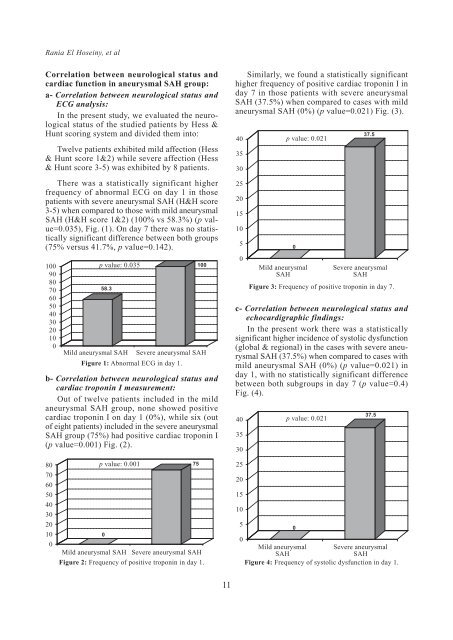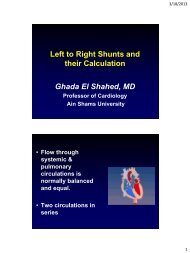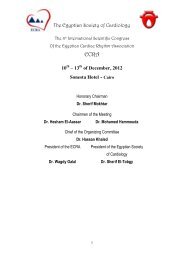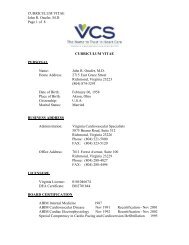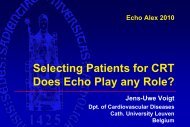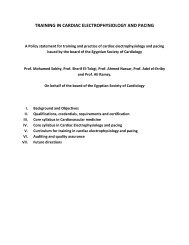the egyptian society of cardiology board of ... - Cardioegypt.com
the egyptian society of cardiology board of ... - Cardioegypt.com
the egyptian society of cardiology board of ... - Cardioegypt.com
Create successful ePaper yourself
Turn your PDF publications into a flip-book with our unique Google optimized e-Paper software.
Rania El Hoseiny, et al<br />
Correlation between neurological status and<br />
cardiac function in aneurysmal SAH group:<br />
a- Correlation between neurological status and<br />
ECG analysis:<br />
In <strong>the</strong> present study, we evaluated <strong>the</strong> neurological<br />
status <strong>of</strong> <strong>the</strong> studied patients by Hess &<br />
Hunt scoring system and divided <strong>the</strong>m into:<br />
Twelve patients exhibited mild affection (Hess<br />
& Hunt score 1&2) while severe affection (Hess<br />
& Hunt score 3-5) was exhibited by 8 patients.<br />
There was a statistically significant higher<br />
frequency <strong>of</strong> abnormal ECG on day 1 in those<br />
patients with severe aneurysmal SAH (H&H score<br />
3-5) when <strong>com</strong>pared to those with mild aneurysmal<br />
SAH (H&H score 1&2) (100% vs 58.3%) (p value=0.035),<br />
Fig. (1). On day 7 <strong>the</strong>re was no statistically<br />
significant difference between both groups<br />
(75% versus 41.7%, p value=0.142).<br />
100<br />
90<br />
80<br />
70<br />
60<br />
50<br />
40<br />
30<br />
20<br />
10<br />
0<br />
p value: 0.035<br />
58.3<br />
100<br />
Mild aneurysmal SAH Severe aneurysmal SAH<br />
Figure 1: Abnormal ECG in day 1.<br />
b- Correlation between neurological status and<br />
cardiac troponin I measurement:<br />
Out <strong>of</strong> twelve patients included in <strong>the</strong> mild<br />
aneurysmal SAH group, none showed positive<br />
cardiac troponin I on day 1 (0%), while six (out<br />
<strong>of</strong> eight patients) included in <strong>the</strong> severe aneurysmal<br />
SAH group (75%) had positive cardiac troponin I<br />
(p value=0.001) Fig. (2).<br />
80<br />
70<br />
60<br />
50<br />
40<br />
30<br />
20<br />
10<br />
0<br />
p value: 0.001<br />
0<br />
Mild aneurysmal SAH Severe aneurysmal SAH<br />
Figure 2: Frequency <strong>of</strong> positive troponin in day 1.<br />
75<br />
11<br />
Similarly, we found a statistically significant<br />
higher frequency <strong>of</strong> positive cardiac troponin I in<br />
day 7 in those patients with severe aneurysmal<br />
SAH (37.5%) when <strong>com</strong>pared to cases with mild<br />
aneurysmal SAH (0%) (p value=0.021) Fig. (3).<br />
40<br />
35<br />
30<br />
25<br />
20<br />
15<br />
10<br />
5<br />
0<br />
p value: 0.021<br />
0<br />
Mild aneurysmal<br />
SAH<br />
37.5<br />
Severe aneurysmal<br />
SAH<br />
Figure 3: Frequency <strong>of</strong> positive troponin in day 7.<br />
c- Correlation between neurological status and<br />
echocardigraphic findings:<br />
In <strong>the</strong> present work <strong>the</strong>re was a statistically<br />
significant higher incidence <strong>of</strong> systolic dysfunction<br />
(global & regional) in <strong>the</strong> cases with severe aneurysmal<br />
SAH (37.5%) when <strong>com</strong>pared to cases with<br />
mild aneurysmal SAH (0%) (p value=0.021) in<br />
day 1, with no statistically significant difference<br />
between both subgroups in day 7 (p value=0.4)<br />
Fig. (4).<br />
40<br />
35<br />
30<br />
25<br />
20<br />
15<br />
10<br />
5<br />
p value: 0.021<br />
0<br />
37.5<br />
0<br />
Mild aneurysmal Severe aneurysmal<br />
SAH<br />
SAH<br />
Figure 4: Frequency <strong>of</strong> systolic dysfunction in day 1.


